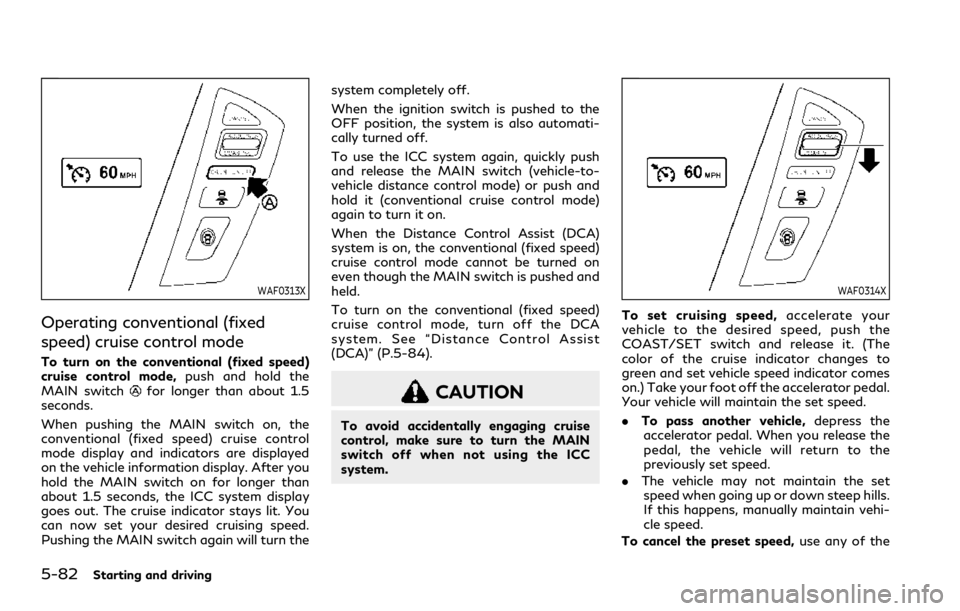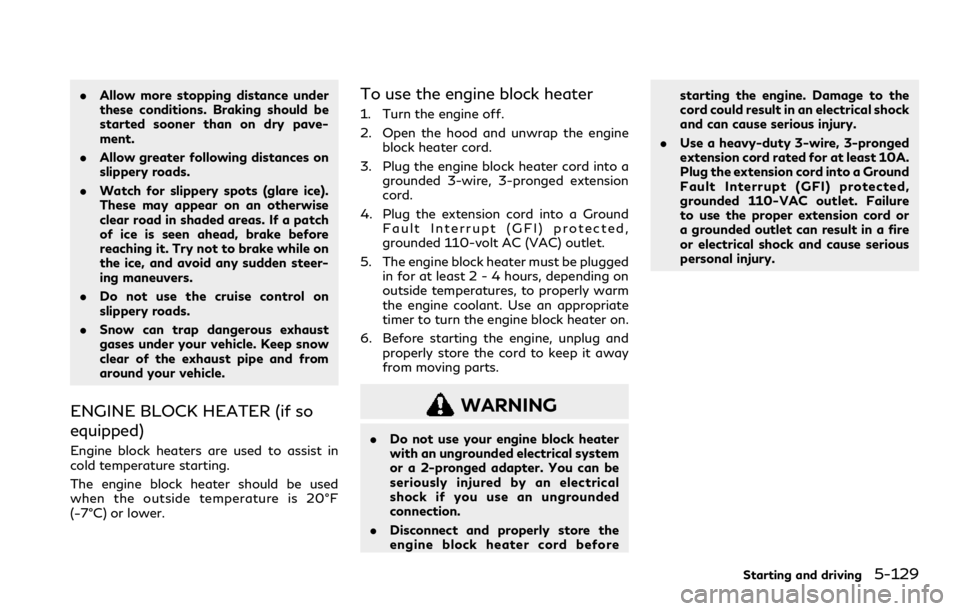Cruise control assist INFINITI QX80 2021 User Guide
[x] Cancel search | Manufacturer: INFINITI, Model Year: 2021, Model line: QX80, Model: INFINITI QX80 2021Pages: 529, PDF Size: 2.05 MB
Page 345 of 529

5-82Starting and driving
WAF0313X
Operating conventional (fixed
speed) cruise control mode
To turn on the conventional (fixed speed)
cruise control mode,push and hold the
MAIN switch
for longer than about 1.5
seconds.
When pushing the MAIN switch on, the
conventional (fixed speed) cruise control
mode display and indicators are displayed
on the vehicle information display. After you
hold the MAIN switch on for longer than
about 1.5 seconds, the ICC system display
goes out. The cruise indicator stays lit. You
can now set your desired cruising speed.
Pushing the MAIN switch again will turn the system completely off.
When the ignition switch is pushed to the
OFF position, the system is also automati-
cally turned off.
To use the ICC system again, quickly push
and release the MAIN switch (vehicle-to-
vehicle distance control mode) or push and
hold it (conventional cruise control mode)
again to turn it on.
When the Distance Control Assist (DCA)
system is on, the conventional (fixed speed)
cruise control mode cannot be turned on
even though the MAIN switch is pushed and
held.
To turn on the conventional (fixed speed)
cruise control mode, turn off the DCA
system. See “Distance Control Assist
(DCA)” (P.5-84).CAUTION
To avoid accidentally engaging cruise
control, make sure to turn the MAIN
switch off when not using the ICC
system.
WAF0314X
To set cruising speed,
accelerate your
vehicle to the desired speed, push the
COAST/SET switch and release it. (The
color of the cruise indicator changes to
green and set vehicle speed indicator comes
on.) Take your foot off the accelerator pedal.
Your vehicle will maintain the set speed.
. To pass another vehicle, depress the
accelerator pedal. When you release the
pedal, the vehicle will return to the
previously set speed.
. The vehicle may not maintain the set
speed when going up or down steep hills.
If this happens, manually maintain vehi-
cle speed.
To cancel the preset speed, use any of the
Page 350 of 529

WAF0348X
System set display without a vehicle
ahead
System set display with a vehicle ahead
System set display with a vehicle ahead
(brake operation is necessary)
The DCA system helps assist the driver to
keep a following distance to the vehicle
ahead by braking and moving the accelera-
tor pedal upward in the normal driving
condition.
When a vehicle ahead is detected:
The vehicle ahead detection indicator (green)
comes on. When the vehicle approaches a vehicle
ahead:
.
If the driver’s foot is not on the accel-
erator pedal, the system activates the
brakes to decelerate smoothly as neces-
sary. If the vehicle ahead comes to a
stop, the vehicle decelerates to a stand-
still within the limitations of the system.
. If the driver’s foot is on the accelerator
pedal, the system moves the accelerator
pedal upward to assist the driver to
release the accelerator pedal.
When brake operation by the driver is
required:
The system alerts the driver by a warning
chime and blinking the vehicle ahead detec- tion indicator (orange). If the driver’s foot is
on the accelerator pedal after the warning,
the system moves the accelerator pedal
upward to assist the driver to switch to the
brake pedal.
NOTE:
.
The stop lights of the vehicle come on
when braking is performed by the DCA
system.
. When the brake operates, a noise may be
heard and/or vibration may be felt. This
is not a malfunction.
Overriding the system:
The following driver’s operation overrides
the system operation.
. When the driver depresses the accelera-
tor pedal even further while the system is
moving the accelerator pedal upward,
the DCA system control of the accel-
erator pedal is canceled.
. When the driver’s foot is on the accel-
erator pedal, the brake control by the
system is not operated.
. When the driver’s foot is on the brake
pedal, neither the brake control nor the
alert by the system operates.
. When the Intelligent Cruise Control (ICC)
system is set, the DCA system will be
cancelled.
Starting and driving5-87
Page 352 of 529

WAF0299X
LDP/BSI/DCA ON indicator (on the
vehicle information display)
Dynamic driver assistance switch
Lower display
TURNING THE DCA SYSTEM ON/
OFF
To turn on the DCA system, push the
dynamic driver assistance switchon the
steering wheel after starting the engine. The
LDP/BSI/DCA ON indicator
in the vehicle
information display will appear. Push the
dynamic driver assistance switch
again to
turn off the DCA system. The LDP/BSI/
DCA ON indicator
will turn off.
The system will start to operate after the
vehicle speed is above approximately 3 MPH
(5 km/h).
The dynamic driver assistance switch
is
used for the Lane Departure Prevention
(LDP), Blind Spot Intervention
®(BSI) and
DCA systems. When the dynamic driver
assistance switch
is pushed, the BSI and
LDP systems will also turn on or off
simultaneously. The DCA system can be
individually set to on or off using the settings
menu on the lower display
. If the system is
set to off, the system will not turn on even if
the dynamic driver assistance switch
is
pushed to on. To set the system to on or off
on the lower display, see “How to enable/
disable the DCA system” (P.5-90).
When the Conventional (fixed speed) cruise
control mode is operating, the DCA system
will not operate. (To use the DCA system,
turn the conventional (fixed speed) cruise
Starting and driving5-89
Page 353 of 529

5-90Starting and driving
control mode off, then push the dynamic
driver assistance switch.)
For details about the Conventional (fixed
speed) cruise control mode, see “Intelligent
Cruise Control (ICC)” (P.5-64).
When the engine is turned off, the system is
automatically turned off.
JVS1214X
HOW TO ENABLE/DISABLE THE
DCA SYSTEM
Perform the following steps to enable or
disable the DCA system.
1. Push the MENU button
and touch
[Driver Assistance] on the lower display.
2. Touch [Forward Assist].
3. Touch [Distance Control] to enable or disable the system.
The displayed keys on the lower display may
vary depending on models, specifications
and software versions.
If the LDP, BSI and DCA systems are set to
off in the lower display and the dynamic driver assistance switch is pushed, the LDP/
BSI/DCA ON indicator will blink for approxi-
mately 2 seconds.
For additional information on LDP and BSI,
refer to “LDP system operation” (P.5-26)
and “Blind Spot Intervention
®(BSI)” (P.5-
41).
Page 392 of 529

.Allow more stopping distance under
these conditions. Braking should be
started sooner than on dry pave-
ment.
. Allow greater following distances on
slippery roads.
. Watch for slippery spots (glare ice).
These may appear on an otherwise
clear road in shaded areas. If a patch
of ice is seen ahead, brake before
reaching it. Try not to brake while on
the ice, and avoid any sudden steer-
ing maneuvers.
. Do not use the cruise control on
slippery roads.
. Snow can trap dangerous exhaust
gases under your vehicle. Keep snow
clear of the exhaust pipe and from
around your vehicle.
ENGINE BLOCK HEATER (if so
equipped)
Engine block heaters are used to assist in
cold temperature starting.
The engine block heater should be used
when the outside temperature is 20°F
(−7°C) or lower.
To use the engine block heater
1. Turn the engine off.
2. Open the hood and unwrap the engine
block heater cord.
3. Plug the engine block heater cord into a grounded 3-wire, 3-pronged extension
cord.
4. Plug the extension cord into a Ground Fault Interrupt (GFI) protected,
grounded 110-volt AC (VAC) outlet.
5. The engine block heater must be plugged in for at least 2 - 4 hours, depending on
outside temperatures, to properly warm
the engine coolant. Use an appropriate
timer to turn the engine block heater on.
6. Before starting the engine, unplug and properly store the cord to keep it away
from moving parts.
WARNING
.Do not use your engine block heater
with an ungrounded electrical system
or a 2-pronged adapter. You can be
seriously injured by an electrical
shock if you use an ungrounded
connection.
. Disconnect and properly store the
engine block heater cord before starting the engine. Damage to the
cord could result in an electrical shock
and can cause serious injury.
. Use a heavy-duty 3-wire, 3-pronged
extension cord rated for at least 10A.
Plug the extension cord into a Ground
Fault Interrupt (GFI) protected,
grounded 110-VAC outlet. Failure
to use the proper extension cord or
a grounded outlet can result in a fire
or electrical shock and cause serious
personal injury.
Starting and driving5-129
Page 510 of 529

4. Release the parking brake.
5. Drive slowly until the vehicle and trailerare clear from the blocks.
6. Apply and hold the brake pedal.
7. Have someone retrieve and store the blocks.
. While going downhill, the weight of the
trailer pushing on the tow vehicle may
decrease overall stability. Therefore, to
maintain adequate control, reduce your
speed and shift to a lower gear. Avoid
long or repeated use of the brakes when
descending a hill, as this reduces their
effectiveness and could cause overheat-
ing. Shifting to a lower gear instead
provides “engine braking” and reduces
the need to brake as frequently.
. If the engine coolant temperature rises to
a high temperature, see “If your vehicle
overheats” (P.6-14).
. Trailer towing requires more fuel than
normal circumstances.
. Avoid towing a trailer for your vehicle’s
first 500 miles (800 km).
. Have your vehicle serviced more often
than at intervals specified in the recom-
mended maintenance schedule shown in
the “9. Maintenance and schedules”
section. .
When making a turn, your trailer wheels
will be closer to the inside of the turn
than your vehicle wheels. To compensate
for this, make a larger than normal
turning radius during the turn.
. Crosswinds and rough roads will ad-
versely affect vehicle/trailer handling,
possibly causing vehicle sway. When
being passed by larger vehicles, be pre-
pared for possible changes in crosswinds
that could affect vehicle handling.
Do the following if the trailer begins to sway:
1. Take your foot off the accelerator pedal to allow the vehicle to coast and steer as
straight ahead as the road conditions
allow. This combination will help stabilize
the vehicle.
.Do not correct trailer sway by steering
or applying the brakes.
2. When the trailer sway stops, gently apply the brakes and pull to the side of
the road in a safe area.
3. Try to rearrange the trailer load so it is balanced as described earlier in this
section.
. Be careful when passing other vehicles.
Passing while towing a trailer requires
considerably more distance than normal
passing. Remember the length of the
trailer must also pass the other vehicle
before you can safely change lanes. .
Use the TOW mode or downshift the
transmission to a lower gear for engine
braking when driving down steep or long
hills. This will help slow the vehicle
without applying the brakes.
. Avoid holding the brake pedal down too
long or too frequently. This could cause
the brakes to overheat, resulting in
reduced braking efficiency.
. Increase your following distance to allow
for greater stopping distances while
towing a trailer. Anticipate stops and
brake gradually.
. INFINITI recommends that the cruise
control not be used while towing a
trailer.
. While towing a trailer, do not use the
following systems (if so equipped):
— the Lane Departure Warning (LDW) system
— the Lane Departure Prevention (LDP) system
— the Blind Spot Warning (BSW) system
— the Blind Spot Intervention
®(BSI)
system
— the Back-up Collision Intervention (BCI) system
— the Intelligent Cruise Control (ICC) system
— the Distance Control Assist (DCA) system
Technical and consumer information10-29
Page 519 of 529

11-2
Cargo light ............................................................. 2-75
Catalytic converter, Three way catalyst ......... 5-4
Center ventilators ................................................ 4-27
Child restraints ...................................................... 1-31Booster seats .................................................. 1-48
LATCH system ............................................... 1-33
Precautions on child restraints .................. 1-31
Top tether strap ............................................. 1-36
Child safety ........................................................... 1-29
Child safety rear door lock .................................. 3-6
Chimes Audible reminders .......................................... 2-19
Seat belt warning light and chime ............ 2-14
Circuit breaker, Fusible link .............................. 8-19
Cleaning exterior and interior .................... 7-2, 7-5
Climate control Automatic air conditioner ........................... 4-29
Automatic climate control ......................... 4-28
Clock ........................................................................\
2-33
Coat hooks ............................................................ 2-65
Cockpit ...................................................................... 2-3
Cold weather driving ........................................ 5-128
Console box ........................................................... 2-63
Console light ......................................................... 2-73
Coolant
Capacities and
recommended fluids/lubricants ................. 10-2
Changing engine coolant ............................... 8-5
Checking engine coolant level ...................... 8-5
Corrosion protection ............................................. 7-8 Cruise control ....................................................... 5-62
Fixed speed cruise control (on
ICC system) .................................................... 5-80
Intelligent cruise control (ICC) system .... 5-64
Cruise indicator .................................................... 2-26
Cup holders ........................................................... 2-60
Current fuel consumption ................................. 2-31
D
Daytime running light system .......................... 2-45
Dimensions ......................................................... 10-10
Distance Control Assist (DCA) system .......... 5-84
Drive belts .............................................................. 8-13
Drive positioner ................................................... 3-40
Driving Cold weather driving ................................. 5-128
Driving with automatic transmission ....... 5-18
On-pavement and off-road driving ........... 5-8
Precautions when starting and driving ..... 5-4
Safety precautions ........................................ 5-10
E
E-Call (SOS) Button ........................................... 2-59
Economy, Fuel .................................................... 5-113
Elapsed time ......................................................... 2-31
Elapsed time and trip odometer ..................... 2-31
Emission control information label ............... 10-12
Emission control system warranty .............. 10-32
EngineBefore starting the engine .......................... 5-15 Break-in schedule ........................................ 5-111
Capacities and
recommended fluids/lubricants ................. 10-2
Changing engine coolant ............................... 8-5
Changing engine oil and filter ...................... 8-6
Checking engine coolant level ...................... 8-5
Checking engine oil level ............................... 8-6
Coolant temperature gauge ......................... 2-8
Emergency engine shut off ......................... 5-14
Engine block heater .................................... 5-129
Engine compartment check locations ........ 8-3
Engine cooling system ................................... 8-4
Engine oil ........................................................... 8-6
Engine oil and oil
filter recommendation .................................. 10-6
Engine oil viscosity ........................................ 10-7
Engine serial number ................................. 10-12
Engine specifications ................................... 10-8
Engine start operation indicator ............... 2-24
If your vehicle overheats ............................. 6-14
Oil pressure gauge .......................................... 2-9
Protection mode ............................................ 5-17
Starting the engine ....................................... 5-15
Entry/exit function, Automatic
drive positioner ................................................... 3-40
Event Data Recorders (EDR) ........................ 10-35
Exhaust gas (carbon monoxide) ........................ 5-4
Explanation of scheduled
maintenance items ................................................. 9-5
Extended storage switch .................................. 8-20
Page 522 of 529

Map lights .............................................................. 2-74
Master warning light .............................. 2-14, 2-18
Mechanical key (Intelligent Key system) .......... 3-3
Memory storage, Automatic
drive positioner ................................................... 3-40
MeterTrip computer ................................................. 2-31
Meters and gauges ................................................ 2-6 Instrument brightness control ................... 2-46
Mirror
Inside mirror ................................................... 3-30
Outside mirrors .............................................. 3-37
Smart Rearview Mirror ................................ 3-31
Vanity mirror ................................................... 3-39
Monitor
Around View
®Monitor .................................. 4-3
Moonroof ............................................................... 2-70
Moving Object Detection (MOD) ................... 4-22
N
New vehicle break-in ........................................ 5-111
O
Odometer .................................................................. 2-7
Off-road recovery .................................................. 5-9
Oil Capacities and
recommended fluids/lubricants ................. 10-2
Changing engine oil and filter ...................... 8-6
Checking engine oil level ............................... 8-6 Engine oil ........................................................... 8-6
Engine oil pressure gauge ............................. 2-9
Engine oil viscosity ........................................ 10-7
Operation, operational indicators ................... 2-24
Outside air temperature .................................... 2-33
Outside mirrors .................................................... 3-37
Overheat, If your vehicle overheats ............... 6-14
Owner’s Manual/Service Manual
order information ............................................. 10-35
P
Panic alarm ............................................................ 3-17
Parking Brake break-in .............................................. 5-123
Parking brake operation .............................. 5-22
Parking on hills ............................................. 5-121
Phone
Car phone or CB radio ................................ 4-38
Pocket ..................................................................... 2-65
Power Front seat adjustment ................................... 1-4
Moonroof ......................................................... 2-70
Power door lock ............................................... 3-4
Power outlet ................................................... 2-56
Power steering fluid ....................................... 8-8
Power steering system .............................. 5-123
Power windows ............................................. 2-68
Precautions Braking precautions .................................... 5-123
Child restraints ............................................... 1-31
Cruise control ................................................. 5-62 Driving safety ................................................. 5-10
Maintenance ..................................................... 8-2
On-pavement and off-road driving ........... 5-8
Seat belt usage .............................................. 1-18
Supplemental restraint system .................. 1-52
When starting and driving ............................ 5-4
Predictive Forward Collision
Warning (PFCW) .............................................. 5-103
Push starting ......................................................... 6-13
Push-button ignition switch ............................. 5-12R
Radio Car phone or CB radio ................................ 4-38
Rain-sensing auto wiper system ..................... 2-38
Rapid air pressure loss .......................................... 5-9
Readiness for inspection/maintenance
(I/M) test ............................................................ 10-34
Rear door alert ..................................................... 2-54
Rear door lock, Child safety rear door lock .... 3-6
Rear personal lights ............................................ 2-74
Rear ventilators .................................................... 4-27
Rear window wiper and washer switch ....... 2-39
Rear window wiper blades ............................... 8-16
Recorders, Event data .................................... 10-35
Registering your vehicle in
another country ................................................. 10-11
Remote engine start ................................ 3-17, 3-19
Remote keyless entry system .......................... 3-15
Reporting safety defects ................................ 10-33
Roadside assistance program ............................. 6-2
11-5